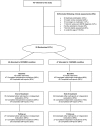Cognitive-behavioural therapy in medication-treated adults with attention-deficit/hyperactivity disorder and co-morbid psychopathology: a randomized controlled trial using multi-level analysis
- PMID: 26022103
- PMCID: PMC4595859
- DOI: 10.1017/S0033291715000756
Cognitive-behavioural therapy in medication-treated adults with attention-deficit/hyperactivity disorder and co-morbid psychopathology: a randomized controlled trial using multi-level analysis
Abstract
Background: Attention-deficit/hyperactivity disorder (ADHD) is a neurodevelopmental disorder characterized by high rates of co-morbid psychopathology. Randomized controlled trials of multimodal interventions, combining pharmacological and psychological treatments, have shown a robust treatment effect for ADHD symptoms but outcomes for co-morbid symptoms have been mixed. This may be accounted for by the type of intervention selected and/or by methodological problems including lack of follow-up and low power. The current study addressed these limitations in a parallel-group randomized controlled trial conducted in Iceland.
Method: A total of 95 adult ADHD patients who were already being treated with medication (MED) were randomly assigned to receive treatment as usual (TAU/MED) or 15 sessions of cognitive-behavioural therapy (CBT/MED) using the R&R2ADHD intervention which employs both group and individual modalities. Primary measures of ADHD symptoms and severity of illness, and secondary measures of anxiety, depression and quality of life were given at baseline, end of treatment and 3-month follow-up. Primary outcomes were rated by clinicians blind to treatment condition assignment.
Results: CBT/MED showed overall (combined outcome at end of treatment and 3-month follow-up) significantly greater reduction in primary outcomes for clinician-rated and self-rated ADHD symptoms. Treatment effect of primary outcomes was maintained at follow-up, which suggests robust and lasting findings. In contrast to the primary outcomes, the secondary outcomes showed significant improvement over time.
Conclusions: The study provides evidence for the effectiveness of R&R2ADHD and demonstrates that there are differential effects over time for ADHD symptoms versus co-morbid problems, the latter taking longer to show positive effects.
Keywords: Attention-deficit/hyperactivity disorder; R & R2; cognitive–behavioural therapy; randomized controlled trials; reasoning and rehabilitation; treatment.
Figures
References
-
- APA (1994). Diagnostic and Statistical Manual of Mental Disorders. American Psychiatric Association: Washington, DC.
-
- Barkley R (1998). Attention Deficit/Hyperactivity Disorder: a Handbook for Diagnosis and Treatment. Guilford Press: New York.
-
- Barkley RA, Murphy K, Fischer M (2008). ADHD in Adults: What the Science Says. Guilford Publications: New York.
-
- Beck A, Steer R (1993). Beck Anxiety Inventory Manual. Harcourt Brace and Company: San Antonio.
-
- Beck A, Ward C, Mendelson M (1961). Beck Depression Inventory (BDI). Archives of General Psychiatry 4, 561–571. - PubMed
Publication types
MeSH terms
Substances
LinkOut - more resources
Full Text Sources
Medical


